Digging into the Data: Travel Nurse Demographics
By Cristal Mackay, Workforce Consulting and Analytics.
.single-post .article-content figure img { max-width: 55%; }Workers from every industry have taken time in recent years to reflect on their personal and professional goals. In healthcare, nearly one in five workers have quit their job during the pandemic, citing COVID-19, poor pay and burnout as reasons.[1] While there has been a significant amount of attention surrounding the increased popularity of travel nursing, only 66,790 registered nurses were employed in the temporary employment market, according to the Bureau of Labor and Statistics May 2021 National Industry-Specific Occupational Employment Report. This only represents 2.34% of the total employment market of 3,047,530 registered nurses.
Why do travel nurses only constitute a small percentage of registered nurses? One leading cause is that it requires a lifestyle that is not a good fit for everyone. Travel nursing requires individuals to leave their homes and the comforts of their social networks and family behind. Because of the unique mobile lifestyle required to be a travel nurse, it raises a question: who is most likely to become one?
We took a deep dive into our data, which encompasses the widest base of travel clinicians, and we uncovered a few noticeable trends in our analysis. We hope this data provides healthcare leaders with insights and takeaways to help develop stronger employer value propositions to retain staff who are likely interested in becoming a travel nurse or recruit travelers into their permanent positions.
The majority of travel nurses are under the age of 35 and single.
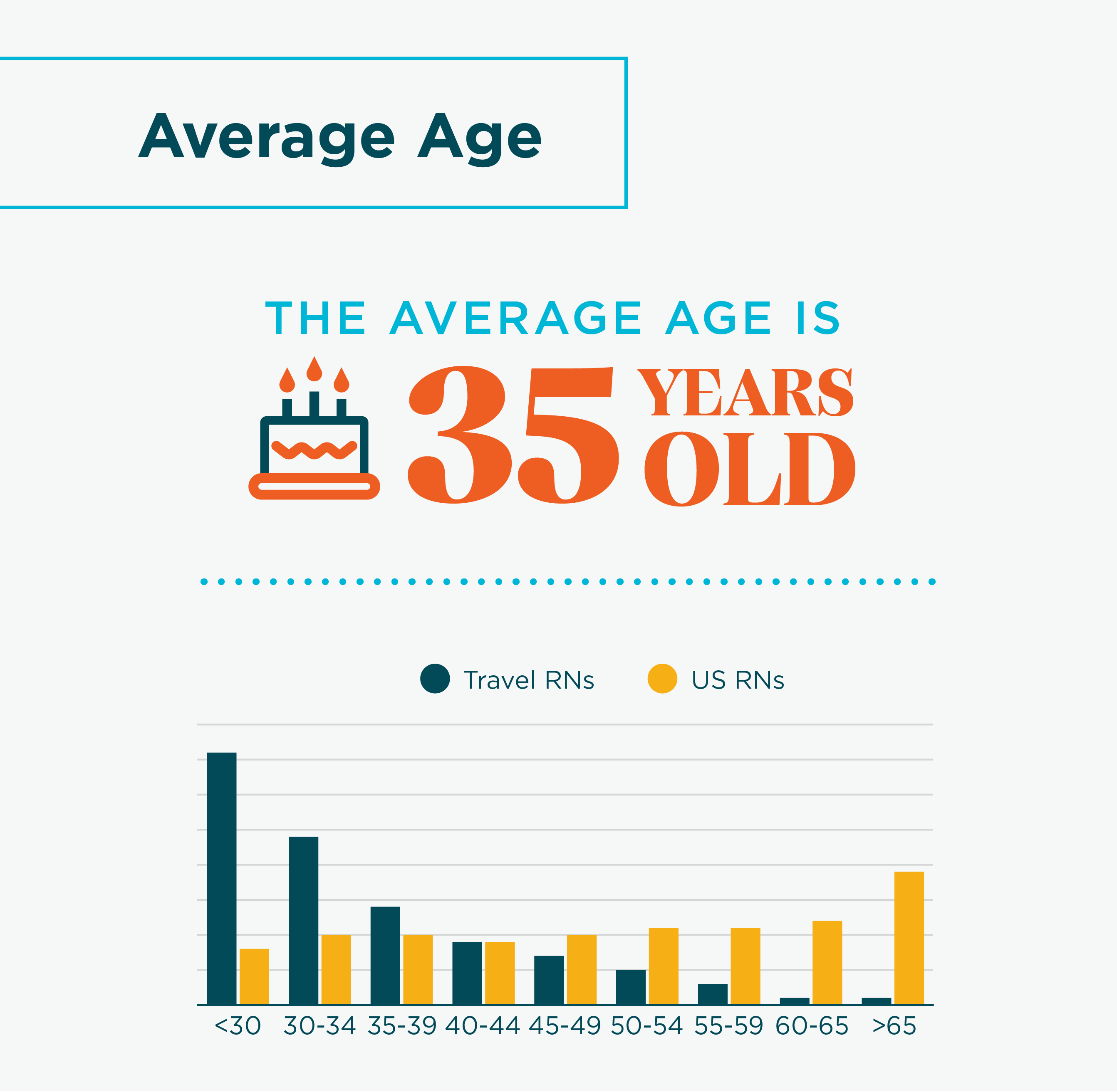
The 2020 National Nursing Workforce Survey by the National Council of State Boards of Nursing states that the average age of registered nurses in the United States is 52 years old and that nearly half of all nurses are over the age of 50. Alternatively, travel nurses have an average age of 35 years and only 11% are over 50.
Additionally, an estimated 71.5% of all RNs are married. The inverse is true of travelers with only 30% married.
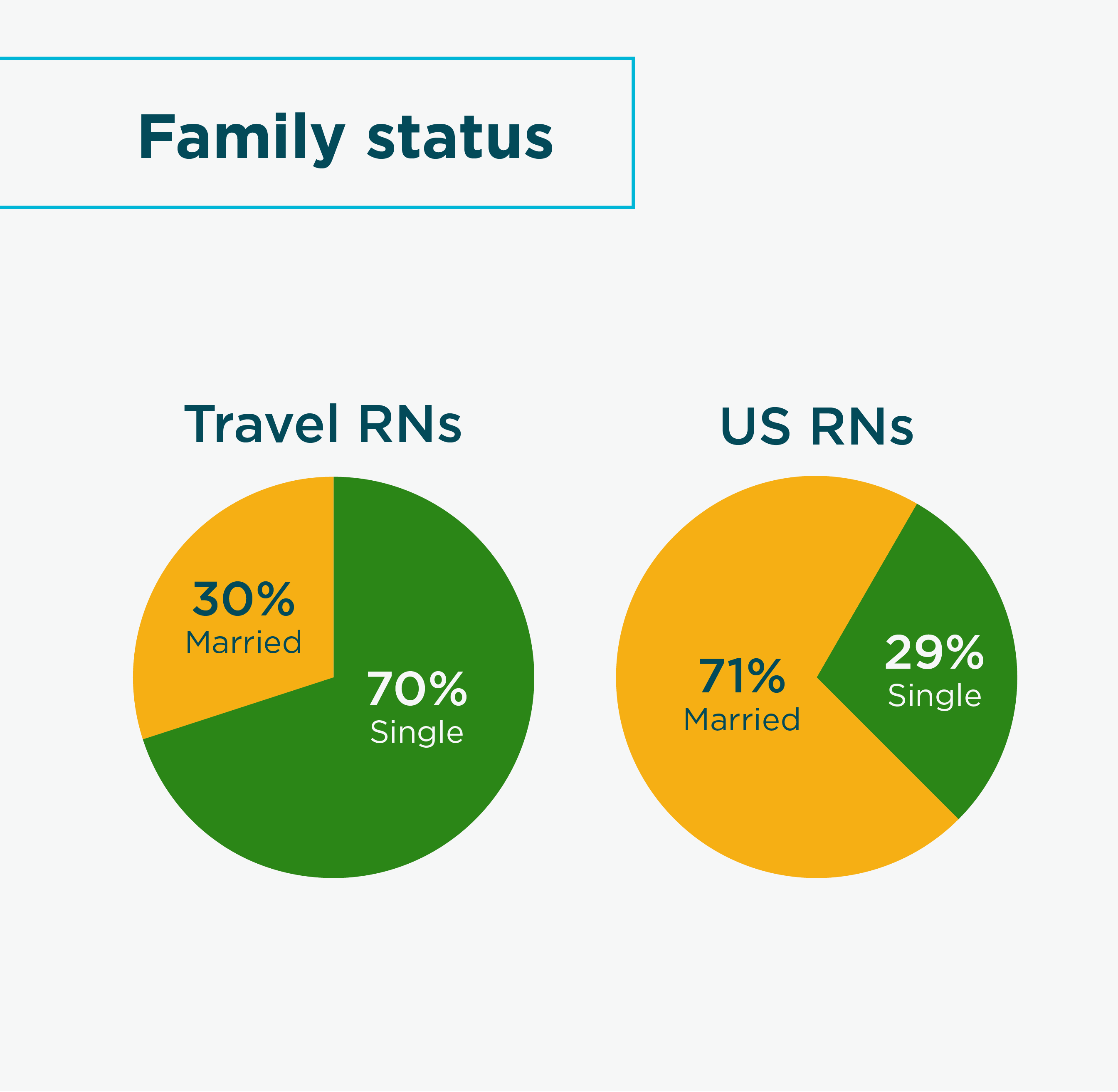
Travel nursing is part of an overall lifestyle choice that has a strong appeal to a younger demographic that is single and able to be more mobile. Traditionally, they are not tied down with a mortgage or have school-aged children. This younger generation of workers as a whole seek more flexibility for work-life balance. According to Deloitte’s Global Millennial survey, 67% of millennials (individuals born 1981–1996, currently between the ages 26–41) feel that flexibility promotes a better work-life balance. In order to attract this demographic into hospital systems for permanent positions, healthcare leaders should explore adopting time off programs beyond the standard paid time off. Some creative types of paid and unpaid leave programs that many companies have incorporated for their employees include unlimited time off, mandatory time off to recharge, time off to volunteer for non-profit causes that are important to them or sabbatical programs.
Many travel nurses, like Kaylee T., a medical-surgical nurse, take time off between assignments to recharge and spend quality time with friends and family. Others, like Kathryn L., an ICU nurse, and Ryan S., a behavioral health nurse, volunteer on medical missions. Some individuals even decide to take longer periods of time off, like Dallas G., an OR nurse, who takes the summers off to work on an organic farm.
Travel nursing provides the flexibility that travel nurses seek from their employers. Because travel nurses usually work on 13-week contracts or shorter, they choose assignments based on their goals and priorities. Whether they use the time between assignments to visit to exotic destinations or enjoy extended time with their family, travel nurses enjoy the flexibility and empowerment that comes from dictating their schedules.
The proportion of male nurses compared to female nurses in travel are nearly double the overall RN workforce percentage.
In the United States, 9.4% of RNs identify as male which is an increase of 0.3 percentage points from 2017. Based on our travel RNs who chose to self-identify, the percentage of male travel RNs is a great deal higher at 18.3%.
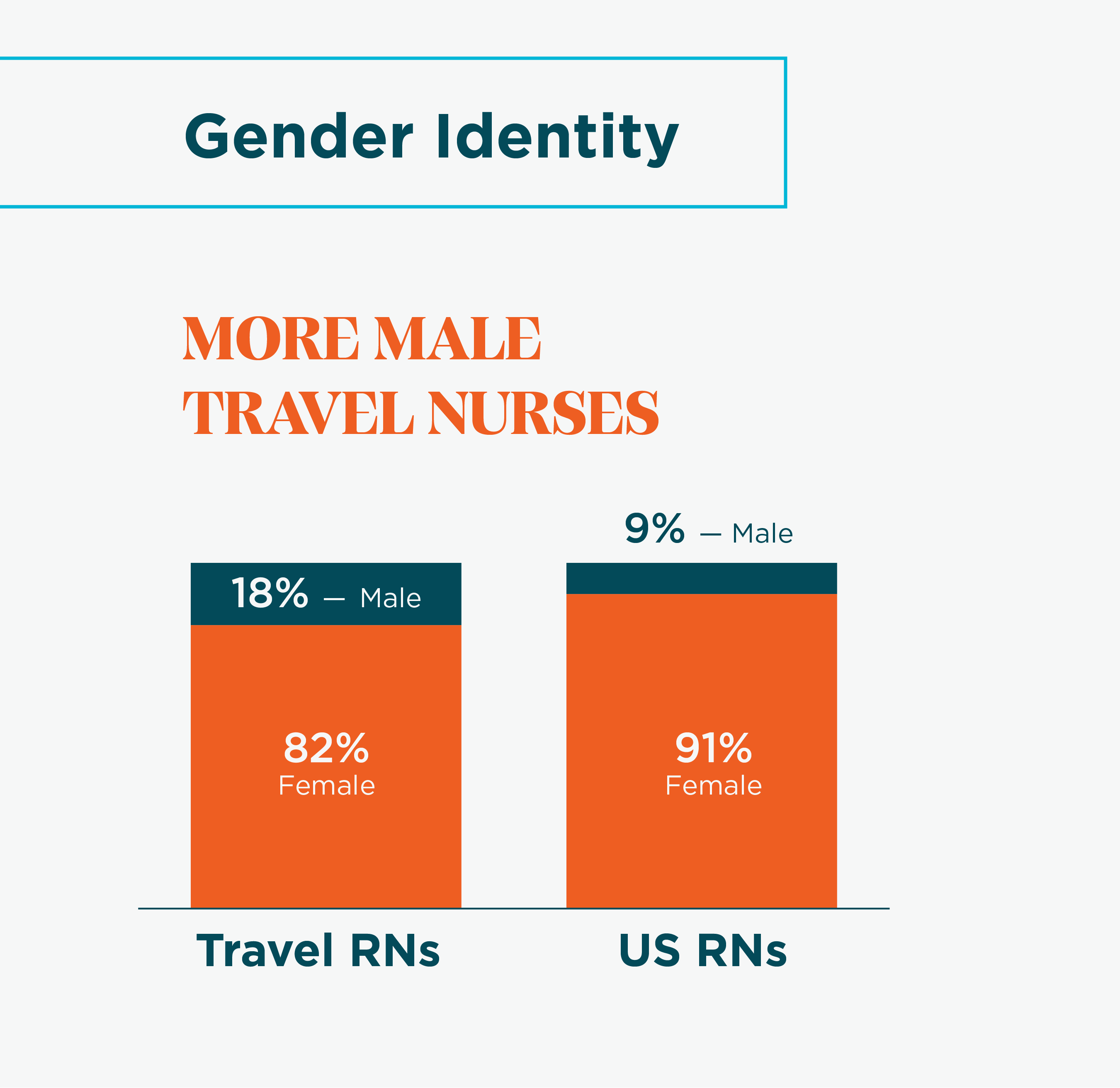
Bianca Frogner, director of the University of Washington’s Center for Health Workforce Studies shares that in a previous UCSF study[2], researchers found that male RNs tend to be slightly younger, more likely to be married and more likely to have children. Frogner states, “While being married with children may make one less mobile, travel nursing provides the financial bandwidth to support a family on a single income, allowing their spouses not to work and move with them. Married traveler nurses may also be coupled with similarly mobile spouses, who may also be health care professionals.”
The travel nurse population is more diverse than US nursing overall.
According to the 2020 National Nursing Workforce Survey, approximately 76% of RNs reported being White/Caucasian. For traveling RNs, only 63% reported being White/Caucasian, with 37% selecting a race/ethnicity other than White/Caucasian, two or more races or other, compared with a 25% rate overall for RNs in the United States.
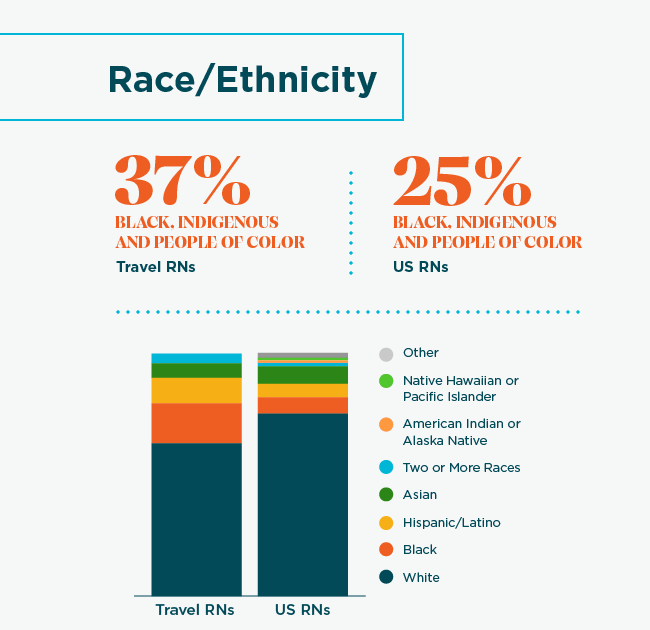
Given the diversity of the travel nurse population, hospitals should consider including travelers in surveys to get a real-time pulse on your organization. Travelers arrive into your health system with a fresh perspective and can give feedback on their experience to determine if your organization and team members are providing an inclusive and supportive environment.
At Aya Healthcare, one aspect of our data-driven approach includes analyzing our data in a multitude of ways for a greater understanding of market trends. We use this data to help our hospital clients optimize their contingent labor programs. More importantly, we help our clients to understand the workforce trends and collaborate on their overall workforce development strategies including permanent recruitment. Our workforce consulting and analytics team can provide a deeper dive into the different aspects of our travel nurse demographics including average years of experience, home state, education background and more. Email [email protected] to schedule a presentation.
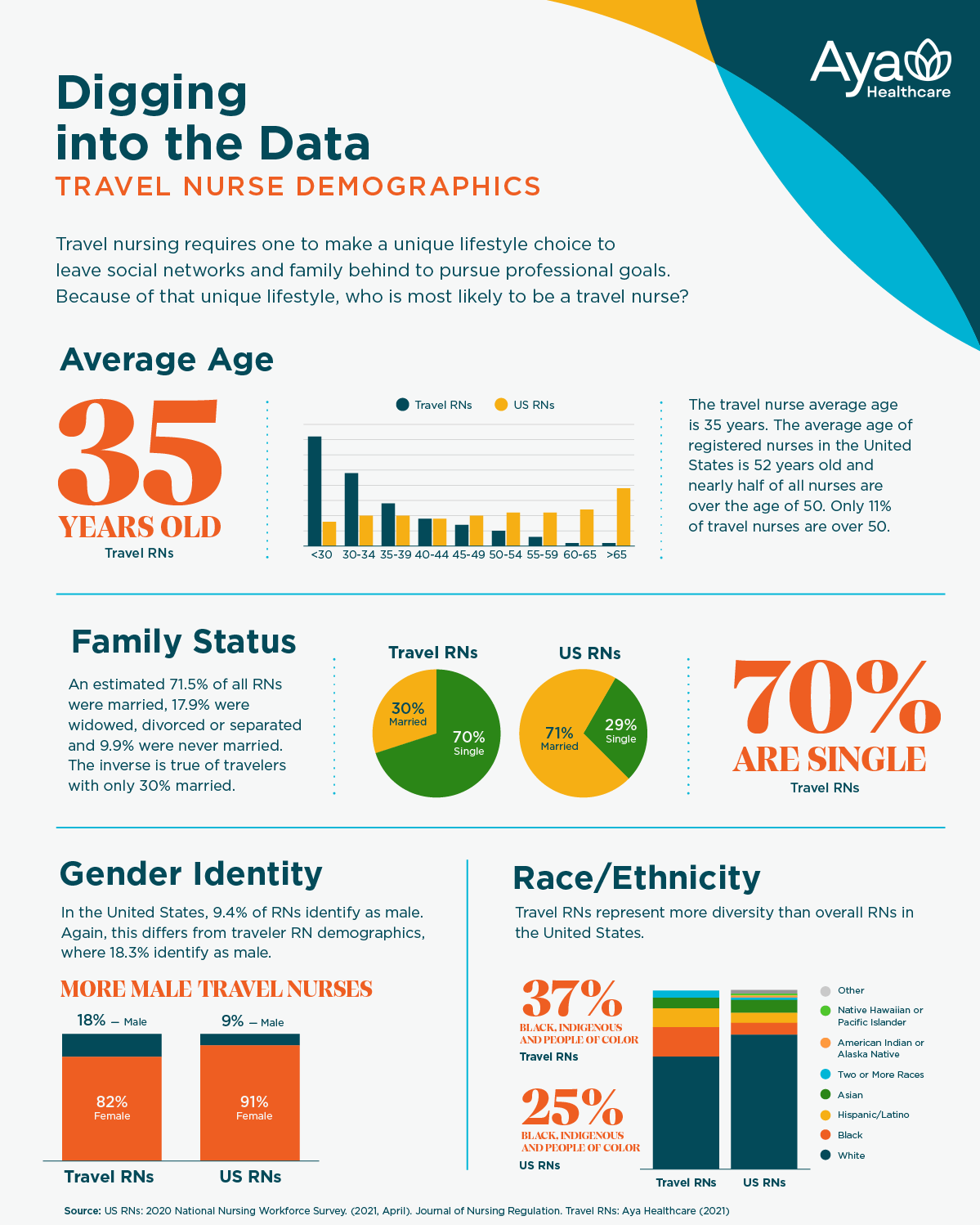
About the Author: Cristal Mackay is Aya Healthcare’s Regional Vice President, Program Management. Her career has included leadership roles at Banner Desert and Cardon Children’s Medical Centers, Ventura County Medical System, Adventist Healthcare and the University of Utah Medical Center. As a mission-driven, hospital Chief Operations Officer, Cristal has been a trailblazer in envisioning and advancing processes and using data-driven methods to move healthcare organizations to higher capabilities in productivity, quality, patient satisfaction and cost containment.
[1] Galvin, G. (2022, April 1). Nearly 1 in 5 Health Care Workers Have Quit Their Jobs During the Pandemic. Morning Consult.
[2] *Muench U, Busch SH, Sindelar J, Buerhaus PI. Exploring Explanations for the Female-Male Earnings Difference Among Registered Nurses in the United States. Nursing Economic$, 2016, 34(5): 214-223.